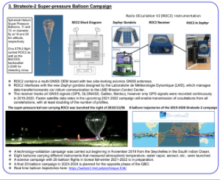Tropical waves observed by balloon-borne GPS Radio Occultation during the equatorial Strateole-2 super-pressure balloon campaign
Bing
Cao
Scripps Institution of Oceanography/ University of California San Diego
Poster
The Strateole-2 stratospheric super-pressure balloons provide a unique opportunity to resolve the structure of tropical waves in the upper troposphere and lower stratosphere using Ballon-borne Radio Occultation (BRO). The balloon carrying the ROC2 multi-GNSS receiver flew for 54 days, traveling as a quasi-Lagrangian tracer and sampling the air mass directly and continuously in both time and space. This type of dataset cannot be replicated with any other ground-based or satellite observing system. We retrieved 40-50 GPS BRO temperature profiles daily over an 800-1000 km distance from ~20 km altitude down to ~8 km over the Indian Ocean and Maritime Continent. The BRO profiles agree closely with those from a dense network of radiosondes over Indonesia and with nearby COSMIC-2 profiles. The BRO profiles show the signal of a large horizontal scale equatorial Kelvin wave with 20-day period and vertical wavelengths shorter than 5 km that is not present in the numerical weather model reanalysis. The BRO profiles also capture a faster wave with ~4-day period and 3-4 km vertical wavelength. The BRO gives a dense and localized distribution of data over the 400-500 km region surrounding the flight track, and offers the potential for investigating the 3-D structure of equatorial waves and determining their intrinsic propagation characteristics. Strateole-2 will continue with two forthcoming campaigns in late 2021 and late 2024, with 20 balloons each, and with four in each campaign carrying the ROC2. These follow-on Strateole-2 campaigns will further investigate wave generation by convection, wave-driving of the QBO, and transport through the tropical tropopause layer.

Poster PDF